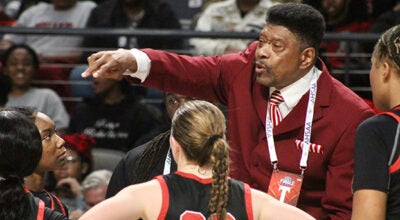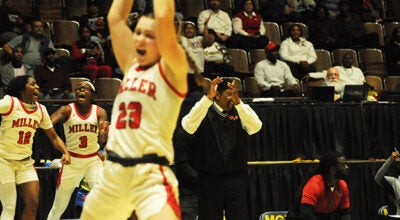Rainer: February deer season was positive
Published 7:54 am Friday, February 21, 2014
By DAVID RAINER
Alabama Department of Conservation and Natural Resources
Now that the 2013-2014 white-tailed deer season is a wrap, Alabama Wildlife and Freshwater Fisheries Division Director Chuck Sykes has some impressions of the season, which featured a few changes and plenty of cold weather.
Regarding the three main changes, Sykes figures it was much ado about nothing.
“I think people got worked up for no reason,” Sykes said. “The February deer season – we’re going to kill all our mature deer – that didn’t happen. For the area definition change – people are going to be getting tickets right and left, and officers are going to have a monumental task of enforcing it – that didn’t happen either. Game Check – we don’t have service, and it’s going to be such a hassle – both untrue.”
For the first time, hunters in southwest Alabama were granted a change in deer season that swapped 10 days of deer hunting in December for hunting the first 10 days of February.
“The February deer season was met with overwhelming positive feedback,” Sykes said. “People in southwest Alabama were allowed to hunt into February, when the majority of the rut occurs. Do I think it made a significant impact on the number of deer killed – no. But it provided an opportunity. That’s what the hunters wanted. As a department, we took the hunters’ requests and combined them with scientifically collected data and made the right management decision, which is the way it should be. Decisions shouldn’t just be based on wants. They should be based on science. In this case, the wants of the hunters matched up with the science that we conducted, so it was a no-brainer.”
The Game Check program, which was voluntary this past season, resulted in a little more than 20,000 reports of deer harvested. As with any new program, there were a couple of small bugs to work out. For example, some people with older lifetime licenses had trouble reporting their harvests. Sykes suggests that anyone with a lifetime license that is more than 10 years old should send it in for a replacement card and updated number free of charge.
“According to the estimate from our mail surveys, and again this is just an estimate, we got three- to four-percent compliance. Wildlife and Freshwater Fisheries (WFF) is going to look at the data and see what information we have. We’re going to take this data and compare it to what we get from the traditional mail survey to see if we get any kind of trend or good comparison. We hope to get more concrete information, especially on a county-by-county basis. Every county reported deer harvests.”
Sykes said it will take a little while to analyze the data with WFF preparing recommendations for the 2014-2015 seasons and bag limits, which will be presented to the Alabama Conservation Advisory Board at its first 2014 meeting on March 1 in Montgomery. That meeting will be held at the Alabama Department of Agriculture and Industries Richard Beard Building Auditorium located at 1445 Federal Dr., Montgomery, Ala., 36107.
“Being the first year (of Game Check), we’ve got to figure out what we’ve got,” he said.
The new regulation states: “as it applies to the hunting of deer and feral swine, there shall be a rebuttable presumption that any bait or feed. . . located beyond 100 yards from the hunter and not within the line of sight of the hunter is not a lure, attraction or enticement to, on or over the area which the hunter is attempting to kill or take the deer or feral swine.” This regulation does not apply to public land. Out of line of sight means obscured from view by natural vegetation or naturally occurring terrain features
“Some people thought it would be a major problem,” Sykes said of the area definition regulation. “Honestly, our conservation enforcement officers issued about the same number of tickets as last year. We tried to make it where landowners could take advantage of trapping and continuing their supplemental feeding programs. That worked like a champ. But outlaws are going to be outlaws. So the tickets our officers were writing were for people sitting anywhere from 30 to 50 yards from the feed. And it was in plain sight.
“Law-abiding hunters took full advantage and it was an overwhelming success. And I talked to a bunch of hunters who decided not to take advantage of it. This was just another opportunity to assist in their land management.”
WFF recently posted the results of its deer reproductive study online (http://outdooralabama.com/images/file/All Data Pooled by Site.pdf) for the public to view.
“Everybody can now look at it online and give us their opinion,” Sykes said. “Again, we’re basing the Department’s recommendation on facts. Facts are pretty clear-cut that the February season is supported and also can be expanded. For me as a biologist working in Alabama my whole career, it confirmed everything we anticipated. Scientifically, we can justify that February deer season. But that’s not the lone issue. We’ve got to look at what landowners want. We’ve got to consider small-game hunters and lengths of seasons. There are a lot of factors we’ll have to look at before we can ultimately make a decision. We’re basing our recommendations on scientific fact, but we’ve got to consider a bunch of other factors before we make our final decisions.
“We will make our recommendations to the Commissioner (N. Gunter Guy Jr.) and advisory board on March 1, and we’ll see what they think about it.”
Sykes said, and it was my experience as well, that a good number of what most people consider trophy deer were taken during the most recent season.
“Overall, I think the three-buck limit has proven valuable,” Sykes said. “We did see quite a few nice deer killed. We had really good deer killed on the WMAs (Wildlife Management Areas). It’s not just private land that is seeing the benefits; it’s public land as well. The thing is, if you want to kill a big deer, you can’t kill him when he’s a yearling. People are learning to pass those younger deer up and beginning to reap the benefits.”
One condition that may have contributed to the harvest of those “trophy” deer was the cold weather, although the wet weather may have affected the deer hunters.
“In my opinion, deer are going to rut when they’re going to rut,” Sykes said. “If it’s 80 degrees, they’re going to do it at night. If it’s 40 degrees, you’re going to see more of the activity during the day.
“It was the coldest winter I can remember. We had a bunch of good days to hunt. But, on the other hand, it rained just about every weekend, so people like me, who have to hunt on the weekends, didn’t have good weather to hunt in. It was good that we had cold weather, but for working guys it may not have worked out.”
Sykes appreciates those who participated in Game Check this past season and encourages everyone with a Smartphone to download the Outdoor Alabama app.
“I killed deer in five counties and it took me less than a minute per deer to register my deer through my phone,” Sykes said. “In most instances, I did it in the tree or in the stand before I ever got down. The biggest issue I had was I had to remember my lifetime license number. That’s what took the most time.”






